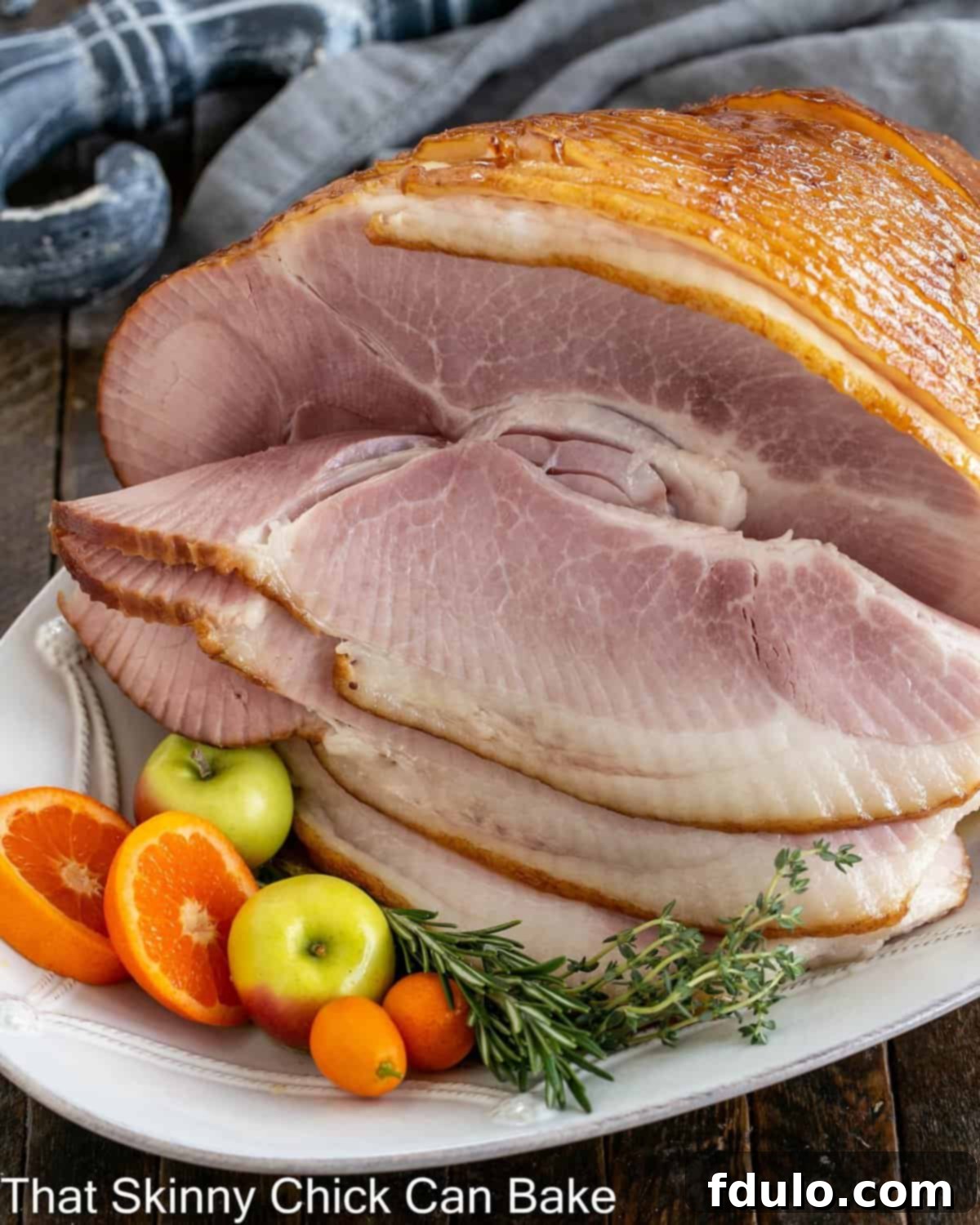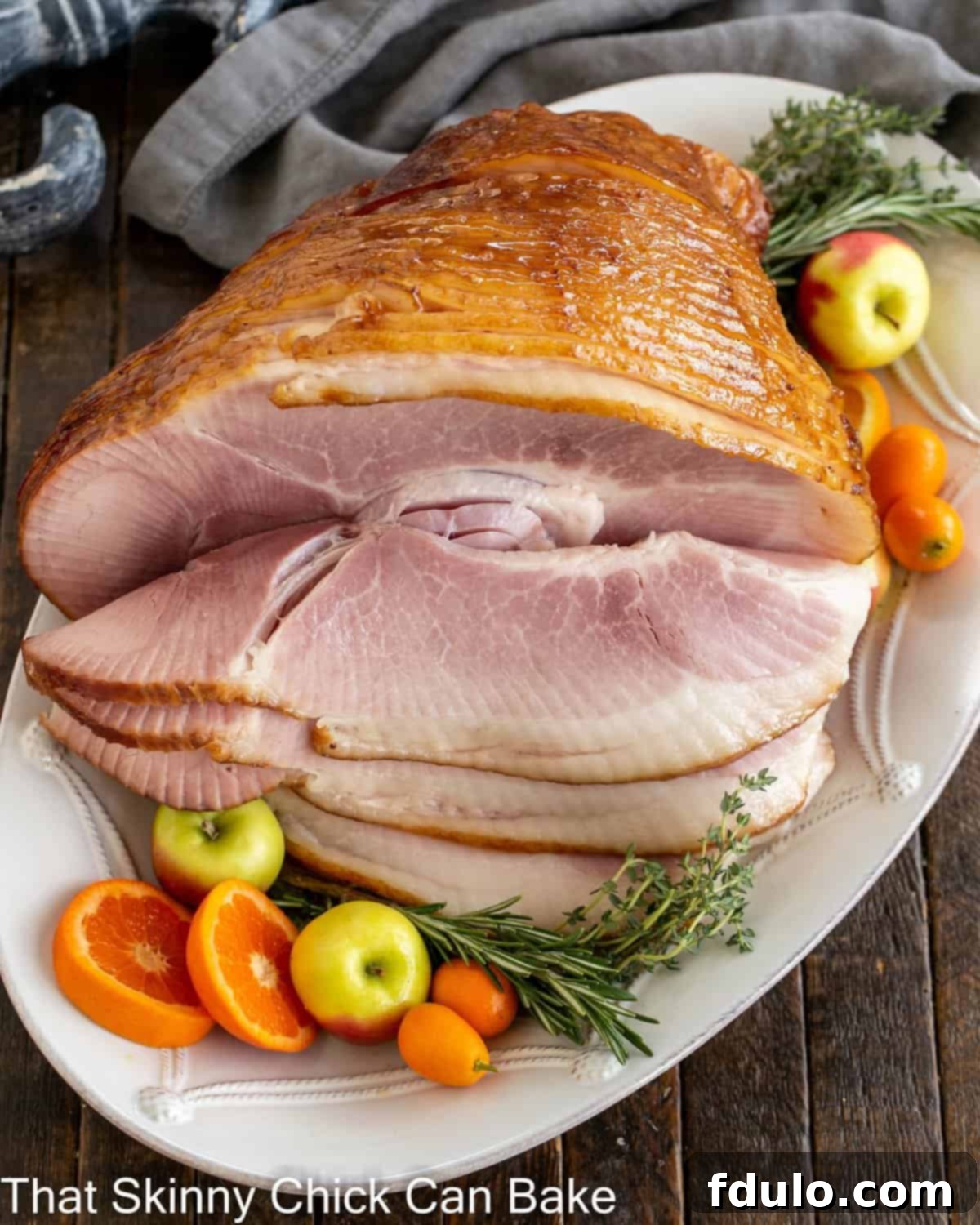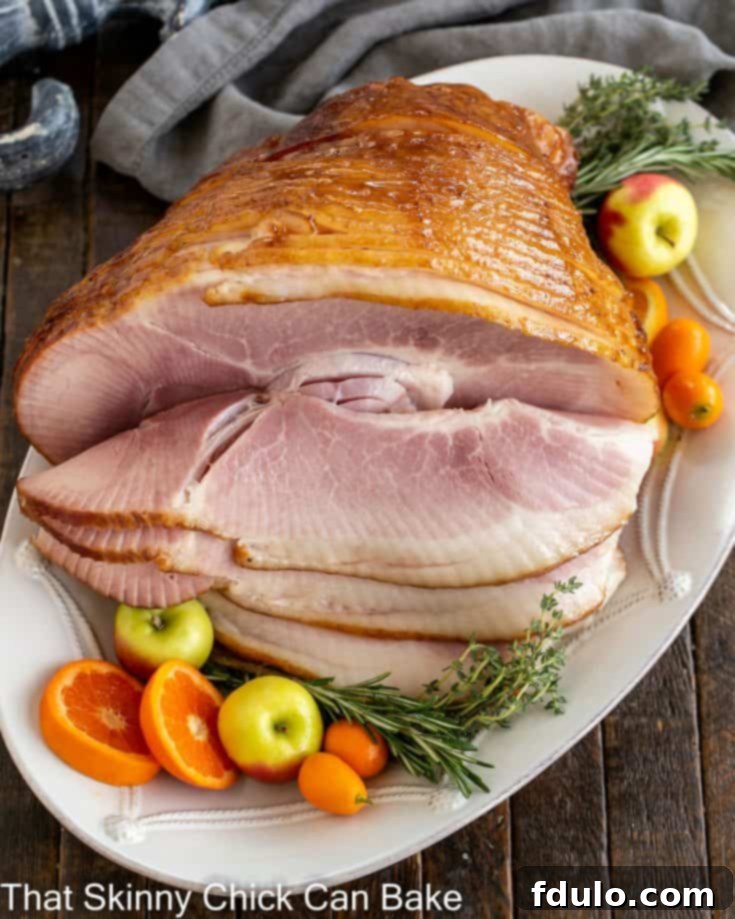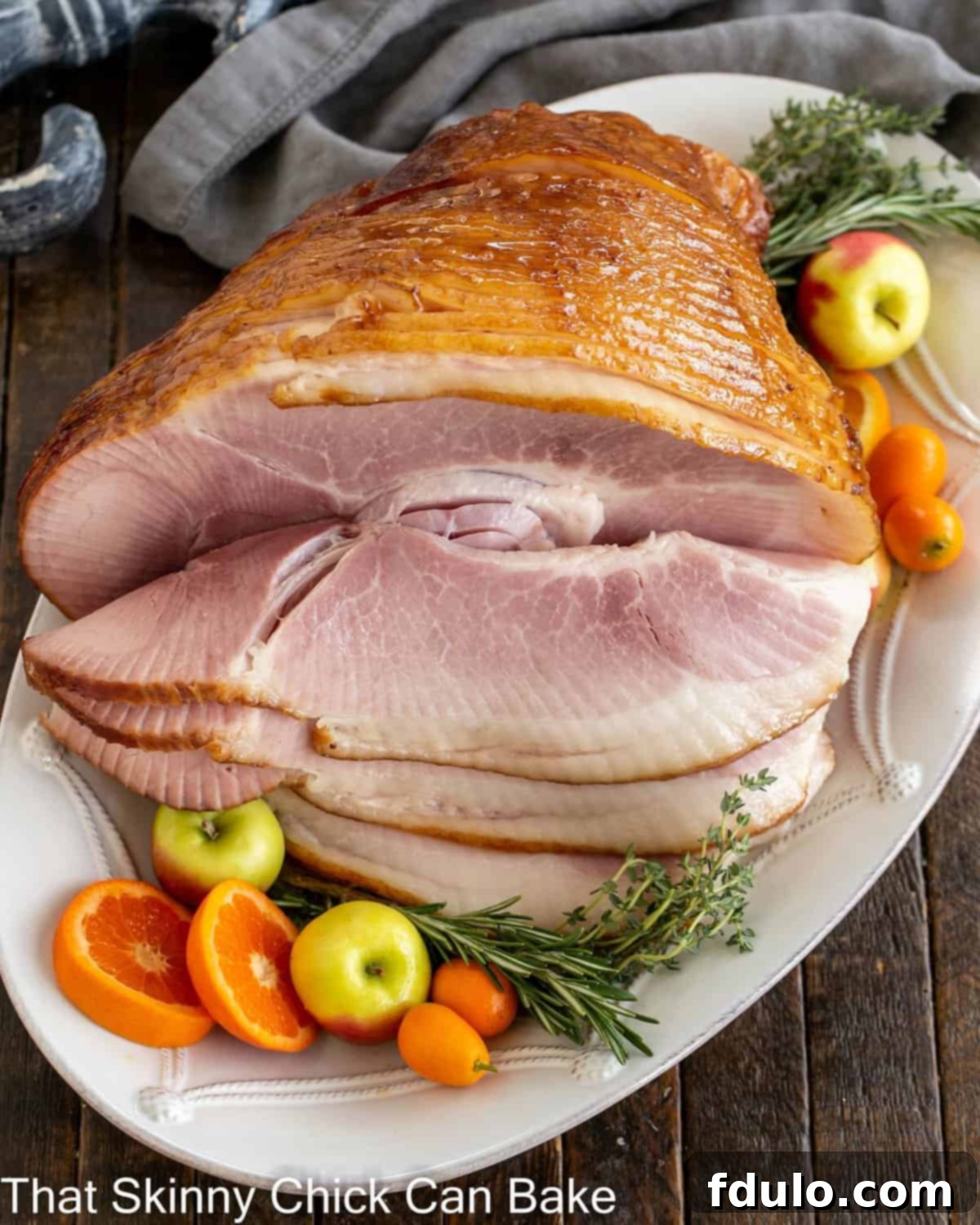Mastering the Art of Glazed Ham: An Effortless Guide to Holiday Perfection
Creating a spectacular Glazed Ham is far simpler and more rewarding than you might imagine. With a homemade glaze, you elevate an ordinary ham into an extraordinary culinary centerpiece, bursting with flavor and visual appeal. Forget about relying on those mystery seasoning packets that often accompany your ham purchase; this recipe puts you in complete control of every wholesome ingredient, ensuring a dish that’s both delicious and free from unwanted additives.
This exquisite Baked Ham Recipe is perfectly tailored for festive holiday celebrations, grand family gatherings, or any occasion that calls for an impressive main course. Once you experience the delightful simplicity and incredible taste of this homemade Honey Mustard Ham Glaze, it’s destined to become a cherished annual tradition in your kitchen. Prepare to impress your guests and delight your family with a ham that’s moist, flavorful, and beautifully caramelized.

Why This Homemade Glazed Ham is a Must-Make
Opting for a homemade glazed ham offers numerous advantages that elevate your dining experience:
- Unmatched Ingredient Control: When you craft your own glaze, you have absolute authority over every single ingredient. This means you can choose high-quality components, adjust sweetness or spice levels to your preference, and avoid artificial flavors, preservatives, or high-fructose corn syrup often found in store-bought options. It’s all about pure, unadulterated flavor.
- Wholesome and Natural Goodness: Say goodbye to questionable additives. Our glaze is made from simple, wholesome ingredients you can trust, ensuring a healthier and more natural dish. There’s no need to use the generic glaze packet that comes with your ham; you can confidently toss it aside and create something truly special from scratch.
- Quick and Easy Preparation: Despite its gourmet taste and impressive appearance, this glaze comes together in mere minutes. Its straightforward preparation means you can achieve outstanding results without spending hours in the kitchen, making it perfect for busy holiday schedules. There’s truly no excuse not to try this fantastic spiral ham recipe! The minimal effort yields maximum flavor and a beautifully caramelized crust that will be the talk of your table.
- Customizable Flavor Profile: A homemade glaze allows for endless customization. You can easily tweak the balance of sweet, savory, and tangy notes, or even introduce unique spices to perfectly match your family’s preferences. This flexibility ensures your glazed ham is uniquely yours and always a crowd-pleaser.
- Impressive Presentation: The rich, golden-brown crust and enticing aroma of a freshly glazed ham make for a stunning presentation. It instantly transforms your meal into a festive feast, creating a memorable dining experience for everyone around the table.
Expert Tips for the Perfect Glazed Ham
Achieving a perfectly moist, tender, and beautifully glazed ham is easier with these insider tips:
- PRO-Tip: Choose a Bone-In Ham for Superior Flavor and Moisture. For the most flavorful and succulent results, always opt for a bone-in ham. The bone infuses the meat with a deeper, richer flavor during cooking, enhancing the overall taste profile. Additionally, the bone helps to insulate the meat, contributing to a more even cook and preventing it from drying out, ensuring every slice is wonderfully moist and tender.
- PRO-Tip: Calculate Ham Quantity Accurately. When planning your meal, consider these guidelines for portioning: if you’re using a boneless ham, aim for approximately ½ pound per person. For a more robust bone-in ham, budget ¾ pound per person. Remember to account for whether you desire leftovers, as this will influence the total weight you should purchase.
- Select a Fully Cooked Ham. For convenience and consistent results, purchase a fully cooked ham, not an uncooked one. Always check the ingredient list carefully to ensure it primarily contains “ham” and avoids unnecessary additives or fillers, indicating a higher quality product.
- Bring Ham to Room Temperature Before Roasting. About an hour before you plan to start roasting, remove the ham from the refrigerator. Allowing it to come closer to room temperature helps to take the chill off the meat, which in turn promotes more even cooking throughout the ham and reduces the overall cooking time.
- PRO-Tip: Bake Your Ham Covered for Optimal Moisture. To prevent your ham from drying out during the initial heating phase, bake it covered with aluminum foil. Place the ham on a rack in a roasting pan with about ½ cup of water or broth in the bottom. This creates a steamy environment that helps the ham reach temperature while remaining incredibly moist. Once heated through, you can remove the foil and begin glazing.
- Customize Your Glaze with Spices. While our honey mustard glaze is fantastic on its own, feel free to personalize it. I often add a touch of ground cloves for warmth, but other aromatic spices like ground cinnamon, a pinch of nutmeg, or dried thyme can also be delicious additions, complementing the ham’s savory notes beautifully. Experiment to find your perfect flavor combination!
- Score Non-Spiral Hams for Better Glaze Adherence and Presentation. If you’re not using a pre-sliced spiral-cut ham, consider cutting a shallow crosshatch pattern into the layer of fat on top of the ham. This not only helps the fat to render down more effectively, resulting in a crispier crust, but also creates a beautiful diamond pattern. For an extra touch of elegance and flavor, you can insert a whole clove into the center of each diamond. This technique ensures the glaze penetrates deeper and adheres wonderfully to the ham’s surface.
- Increase Oven Temperature for a Beautifully Browned Crust. After you’ve spooned or brushed the glaze onto the ham multiple times, increase the oven temperature during the final stages of cooking. This higher heat helps to caramelize the sugars in the glaze, creating a stunning, golden-brown crust with a delightful sticky texture.
- PRO-Tip: Monitor Your Glazed Ham Closely. When the oven temperature is elevated for browning, it’s crucial to watch your ham very carefully. The sugars in the glaze can burn quickly, turning bitter. Keep an eye on it and remove it from the oven as soon as the glaze reaches a rich, golden-brown color.
- Allow Your Ham to Rest Before Carving. Once you pull the glazed ham from the oven, resist the urge to carve it immediately. Instead, cover it loosely with foil and let it rest for about 10-15 minutes. This vital step allows the juices within the meat to redistribute throughout, resulting in a more tender, succulent, and flavorful ham. Always serve your glazed ham warm for the best taste and texture.

Delectable Serving Suggestions for Your Glazed Ham
A perfectly glazed ham deserves equally delicious accompaniments to complete your festive meal. Here are some fantastic recipes that beautifully complement the sweet and savory notes of your baked ham:
- Creamy Scalloped Potatoes or rich Cream Cheese Mashed Potatoes for a comforting classic side.
- Elevate your vegetable game with beautifully Roasted Vegetables like crisp Garlic Parmesan Roasted Green Beans, tender Roasted Asparagus with Balsamic Browned Butter, or sweet and savory Honey Balsamic Roasted Carrots.
- For another delightful carrot dish, try this specific Glazed Carrots Recipe.
- A comforting Easy Corn Casserole adds a touch of sweetness and creamy texture.
- Hearty Homemade Boston Baked Beans provide a savory and slightly sweet counterpoint.
- Light and airy Spinach Soufflé offers a delicate, elegant touch.
- Fluffy, warm Buttery Homemade Crescent Rolls are perfect for soaking up any extra glaze or juices.
Creative Ways to Utilize Leftover Glazed Ham
One of the best parts about making a large ham, especially for the holidays, is the abundance of delicious leftovers! Far from being a chore, leftover glazed ham is incredibly versatile and can add a smoky, savory depth to countless dishes. Beyond the wonderful recipes listed below, the possibilities are truly endless:
For quick and easy meals, layer slices of ham into classic ham sandwiches or whip up adorable ham sliders for a crowd. Dice or shred leftover ham and incorporate it into hearty soups, like my comforting Split Pea Soup, or add it to creamy casseroles for an extra boost of flavor and protein. Instead of bacon, pan-fry some thin slices of ham to serve alongside your morning eggs, or chop it up and mix it into a breakfast scramble or omelet.
Thinking outside the box? Substitute ham for corned beef when making a savory hash, creating a delicious twist on a traditional favorite. Or how about adding some chopped glazed ham to a quiche or frittata for an elevated brunch or light dinner? You can even stir it into pasta dishes, rice pilafs, or use it as a pizza topping. The options are truly limitless, as ham’s distinct smoky and savory flavor profile enhances so many different cuisines and meal types, making your leftovers just as exciting as the original feast.

Frequently Asked Questions About Glazed Ham
Glazing a ham serves multiple wonderful purposes that transform your baked ham into a culinary masterpiece. Firstly, it imparts a stunning, rich color to the exterior, creating that inviting, caramelized sheen that makes the ham look incredibly appetizing. Beyond aesthetics, the sweet and tangy flavors of the glaze perfectly complement the inherent salty and savory notes of the ham, creating a balanced and irresistible taste experience. If you finish the glazing process by placing the ham under the broiler or by increasing the oven temperature, it also helps to create a slightly crispy, texturally pleasing crust, especially if the fatty portions caramelize. However, it’s crucial to watch it carefully to prevent the sugars from burning, which can lead to a bitter taste.
The timing of your glaze application is key to achieving optimal results. You should typically begin glazing your ham towards the end of its cooking process. First, cook your ham covered with foil until it is thoroughly heated through. This initial phase, which usually takes about 1 to 1½ hours depending on the ham’s size and whether it’s bone-in or boneless, focuses on bringing the internal temperature of the ham up gently while keeping it moist. Once the ham is heated through, remove the foil, turn up the oven temperature (often to 375°F-400°F/190°C-200°C), and then start applying your glaze. Brush the ham generously with the glaze every 10 to 15 minutes, repeating this process 2-3 more times to build up layers of flavor and achieve a beautiful caramelized crust. This final, higher-heat stage allows the glaze to set and brown without burning the sugars prematurely.
Determining the right size ham depends primarily on your guest count and whether you’re hoping for leftovers. A general rule of thumb is to calculate approximately ½ pound of ham per person if you are purchasing a boneless ham. For a bone-in ham, which yields less meat per pound due to the bone, you’ll need about ¾ pound of ham per person. So, if you’re serving 8 people with a bone-in ham, you’d aim for a 6-pound ham (8 x 0.75 = 6). Always factor in whether you want ample leftovers for sandwiches, soups, or other dishes, in which case you might consider buying a slightly larger ham. For very large gatherings, multiple smaller hams can sometimes be more manageable than one extremely large one.
The baking time for a ham can vary significantly based on several factors, including its size, whether it’s bone-in or boneless, and your oven’s specific calibration. For a fully cooked ham, the goal is to simply reheat it thoroughly to an internal temperature of 140°F (60°C) for food safety before serving, although some prefer it slightly warmer up to 150°F (66°C). As a general guideline, a fully cooked ham typically requires about 10-15 minutes per pound when baked at 325°F (160°C). Always use a reliable meat thermometer inserted into the thickest part of the ham, avoiding the bone, to accurately check for doneness. This ensures your ham is heated through without becoming dry, providing a perfectly cooked and safe meal.
Explore More Delicious Recipes
If you loved this Honey Mustard Glazed Ham, you might also enjoy these related recipes:
- Ham Salad Recipe from Spend with Pennies for a delightful use of leftovers.
- Hearty Navy Bean Soup with Ham, perfect for a comforting meal.
- Easy and delicious Ham and Cheese Breakfast Sliders.
- Discover more Easy Main Dish Recipes for any occasion.
Stay connected and share your culinary creations with us! Follow Liz Berg on social media @ Instagram, Facebook, and Pinterest. Don’t forget to tag me when you try one of my recipes! And if you love the results, please consider giving it a 5-star rating in the recipe card below to help other home cooks find and enjoy it.

Honey Mustard Glazed Ham Recipe
10 minutes
1 hour 30 minutes (initial heating) + 45 minutes (glazing/browning)
10 minutes (resting)
2 hours 20 minutes
10-12 servings
This simple yet sensational ham glaze transforms your holiday ham from ordinary to absolutely extraordinary! Featuring a perfect balance of sweet honey and tangy mustard, it creates a caramelized crust that seals in moisture and amplifies flavor. This recipe is an ideal main dish for Easter, Christmas, or any special occasion, promising rave reviews and a memorable feast.
5.0 (20 ratings)
Ingredients
- 1 bone-in, fully cooked 8-10 pound ham
- ½ cup water (for the roasting pan)
- 4 tablespoons unsalted butter
- ½ cup high-quality honey
- 1 cup packed light brown sugar
- 1 tablespoon Dijon mustard
- 1 tablespoon whole grain mustard
- ⅛ teaspoon ground cloves (or more, to taste)
Instructions
- Prepare the Ham: Approximately one hour before you plan to start roasting, remove the fully cooked ham from the refrigerator. This allows it to come to a more even temperature, ensuring it cooks more uniformly.
- Preheat Oven: When you are ready to begin roasting, preheat your oven to 325°F (160°C).
- Set Up Roasting Pan: Place the ham, cut side down, on a sturdy roasting rack inside a large roasting pan. Pour ½ cup of water into the bottom of the pan to create a moist cooking environment. Tightly cover the entire roasting pan with heavy-duty aluminum foil.
- Initial Baking: Bake the covered ham for approximately 1 to 1½ hours, or until it is thoroughly heated through to an internal temperature of 140°F (60°C). Use a meat thermometer inserted into the thickest part (avoiding the bone) to verify.
- Prepare the Glaze: While the ham is in the oven, begin preparing your flavorful honey mustard glaze.
- Combine Glaze Ingredients: In a small saucepan over medium-low heat, melt the unsalted butter. Once melted, add the honey, brown sugar, Dijon mustard, whole grain mustard, and ground cloves. Stir all the ingredients together thoroughly. Simmer gently, stirring occasionally, until the brown sugar has completely dissolved and the glaze is smooth and slightly thickened, about 3-5 minutes. Remove from heat.
- First Glazing Application: Once the ham is hot and heated through, carefully remove it from the oven and discard the foil. Increase the oven temperature to 375°F (190°C). Generously brush or spoon a layer of the prepared glaze over the entire surface of the ham. Return the ham to the oven and cook for about 15 minutes.
- Repeat Glazing: Remove the ham from the oven again. Apply another generous layer of glaze, ensuring full coverage. Return to the oven and cook for another 15 minutes. Repeat this glazing process one or two more times, at 15-minute intervals, until the ham is beautifully coated and has developed a rich, sticky crust.
- Final Browning: For a deeper caramelized crust, increase the oven temperature to 400°F (200°C) for the last 10-15 minutes of cooking. Apply a final brush of glaze. Watch the ham very carefully during this stage, as the sugars in the glaze can burn quickly at high temperatures. Remove from the oven once the glaze is a deep, golden brown.
- Rest and Serve: Once removed from the oven, immediately cover the glazed ham loosely with foil. Allow it to rest for at least 10 minutes (or up to 20 minutes for larger hams) before carving. This crucial resting period allows the juices to redistribute throughout the meat, resulting in a more tender and flavorful ham. Carve and serve your magnificent glazed ham warm!
Notes
Feel free to adjust the amount of ground cloves to your liking, or add other warming spices such as a pinch of cinnamon or a dash of dried thyme for additional flavor dimensions. These spices complement the ham beautifully.
The quantities listed in this recipe are designed for a larger (8-10 pound) ham. If you are preparing a smaller ham, you can easily halve the glaze ingredients to avoid waste while still ensuring ample coverage.
Recommended Products
As an Amazon Associate and member of other affiliate programs, I earn from qualifying purchases.
- Thermapen Instant Read Thermometer
- Silicone Pastry Brush
- Heavy Duty Aluminum Foil
- Roasting Pan
Nutrition Information:
Yield:
12 servings
Serving Size:
1 slice (approx.)
Amount Per Serving (Estimated):
Calories: 557Total Fat: 19gSaturated Fat: 5gTrans Fat: 0gUnsaturated Fat: 9gCholesterol: 204mgSodium: 3038mgCarbohydrates: 30gFiber: 0gSugar: 30gProtein: 67g
Thatskinnychickcanbake.com occasionally offers nutritional information for recipes contained on this site. This information is provided as a courtesy and is an estimate only. This information comes from online calculators and may vary. Although thatskinnychickcanbake.com attempts to provide accurate nutritional information, these figures are only estimates.
Varying factors such as product types, brands purchased, and exact ingredient measurements can significantly change the nutritional information in any given recipe. Additionally, many recipes on thatskinnychickcanbake.com recommend toppings or optional ingredients, and nutritional information for these added components is typically not included. Other factors, such as salt amounts listed “to taste,” are not calculated into the recipe as the quantity will vary. Furthermore, different online calculators can yield different results.
To obtain the most precise representation of the nutritional information for any given recipe, you should calculate the nutritional values using the actual ingredients and exact quantities you incorporate into your specific preparation. You are solely responsible for verifying the accuracy of any nutritional information obtained.
HOW MUCH DID YOU LOVE THIS RECIPE?
Please leave a comment on the blog or share a photo on Pinterest
